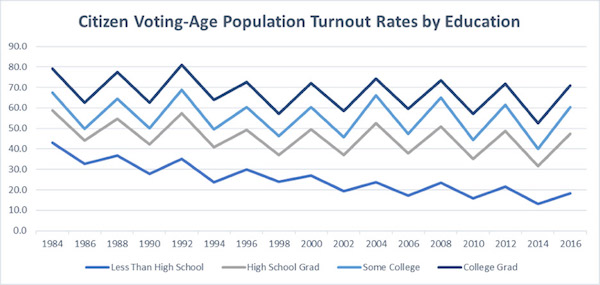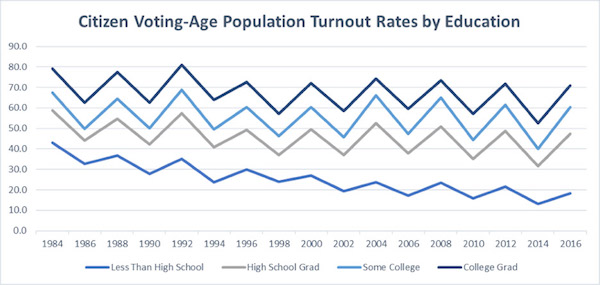The Voters Quiz - Module 4
1/9
There's no tags or description
Looks like no tags are added yet.
Name | Mastery | Learn | Test | Matching | Spaced |
|---|
No study sessions yet.
10 Terms
Which statement describes a constitutional expansion of voting rights? (5 points)
Individuals need proof of citizenship to register to vote. |
States cannot require poll taxes in federal elections. |
The states are responsible to oversee federal elections. |
Voters are required to register to vote before the election. |
States cannot require poll taxes in federal elections.
Which statement describes a barrier to voting? (5 points)
Polling locations require voters to prove their identity before voting. |
Senators are elected by the popular vote of state populations. |
States are prohibited from requiring poll taxes in federal elections. |
The set voting age for federal elections is 18 years. |
Polling locations require voters to prove their identity before voting.
Which model of voting behavior describes voting decisions based around issues that directly concern and affect the voter? (5 points)
Party-line voting |
Prospective voting |
Rational choice |
Retrospective voting |
Rational choice
"Studies of voting behavior in recent elections have consistently shown that persons under 30 vote less often than those who are older. In 1963, President Kennedy's Commission on Registration and Voting Participation expressed its deep concern over the low voting participation in the 21–30-year-old age bracket. It attributed this low participation to the fact that: 'by the time they have turned 21 ... many young people are so far removed from the stimulation of the educational process that their interest in public affairs has waned. Some may be lost as voters for the rest of their lives.'"—Senator Ted Kennedy (D, Mass.)
Based on the excerpt, which of the following legal protections would the speaker most likely support? (5 points)
Senators are elected by the popular vote of state populations. |
States are prohibited from requiring poll taxes in federal elections. |
The right to vote cannot be limited based on race or gender. |
The voting age in federal elections is set to 18 years old. |
The voting age in federal elections is set to 18 years old.

Which of the following statements reflects the data in the graph? (5 points)
Those with less education are more likely to vote. |
Those with more education are more likely to vote. |
Those who are older are more likely to vote. |
Those who are younger are more likely to vote. |
Those with more eduction are more likely to vote.

Which of the following is a potential consequence of the trend illustrated in the line graph? (5 points)
High voter turnout among those with less education is evidence of voter satisfaction with likely winners or parties. |
High voter turnout among those with more education results in low voter approval with the officials who are elected. |
Low voter turnout among those with more education is evidence of the legitimacy of the current election system. |
Low voter turnout among those with less education can result in unequal representation across the population. |
Low voter turnout among those with less eduction can result in unequal representation across the population.
Voter Turnout in the U.S. Based on Year and Type of Election
Year | Type | Voter Turnout (% of eligible) |
|---|---|---|
2008 | General | 61.6 |
2010 | Mid-term | 41 |
2012 | General | 58.2 |
2014 | Mid-term | 35.9 |
2016 | General | 60 |
Source: Fairvote.org
Which of the following most likely accounts for the trend shown in the table? (5 points)
Voter ID requirements at polling locations negatively affect voter turnout. |
Voter turnout is positively affected by the education level of the voter. |
Issues with transportation to polls and polling hours affect voter turnout. |
Americans' perspectives about election importance affect voter turnout. |
American’s perspectives about election importance affect voter turnout.
Which of the following is an accurate comparison of the rational choice and party-line models of voting behavior? (5 points)
Rational Choice | Party-Line Voting | |
|---|---|---|
(A) | Based on what is in the citizen's individual best interest | Based on party preferences, regardless of issues |
(B) | Based on party or candidate's recent actions on an issue | Based on estimates of how a candidate will decide on issues |
(C) | Based on voter's previous history of party support | Based on party or candidate performance in the recent past |
(D) | Based on predictions of how a party or candidate will perform in the future | Based on policies that directly affect the citizen's life |
(A) |
(B) |
(C) |
(D) |
A
Which of the following is an accurate comparison of the retrospective and prospective models of voting behavior? (5 points)
Retrospective | Prospective | |
|---|---|---|
(A) | Based on what is in the citizen's individual best interest | Based on party preferences, regardless of issues |
(B) | Based on party or candidate's recent actions on an issue | Based on estimates of how a candidate will decide on issues |
(C) | Based on voter's previous history of party support | Based on party or candidate performance in the recent past |
(D) | Based on predictions of how a party or candidate will perform in the future | Based on policies that directly affect the citizen's life |
(A) |
(B) |
(C) |
(D) |
B
It is estimated that, overall, 1 in 10 Americans do not have a government-issued photo ID, while approximately 1 in 4 African Americans do not have a government-issued photo ID.
Based on this scenario, requiring a photo ID to vote in elections could impact the African American voter turnout rate through (5 points)
campaign negativity |
demographics |
political parties |
structural barriers |
structural barriers